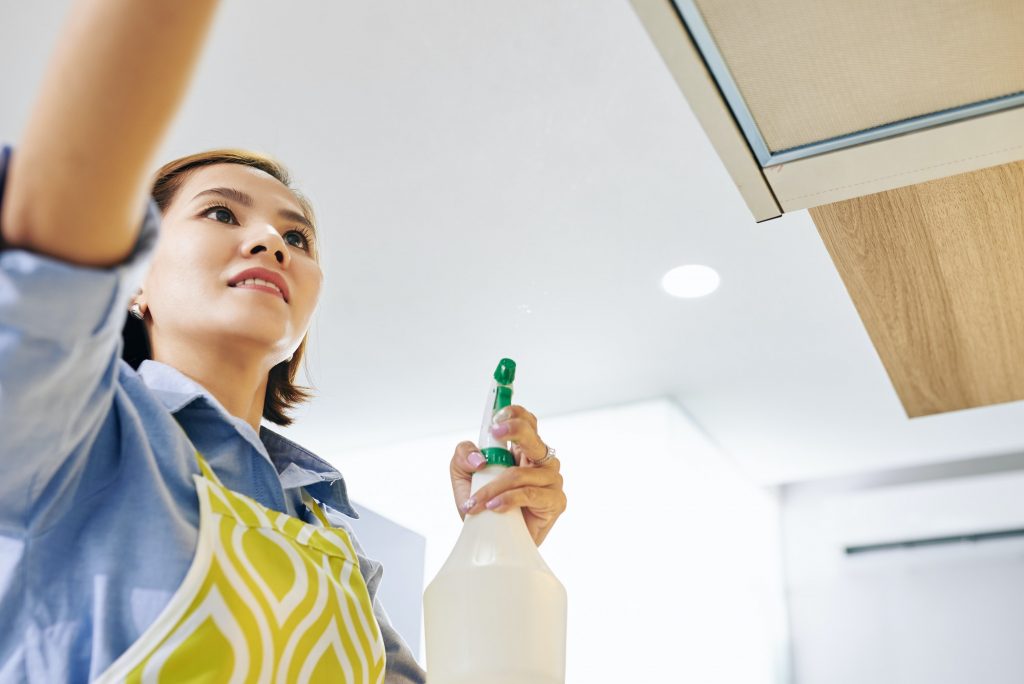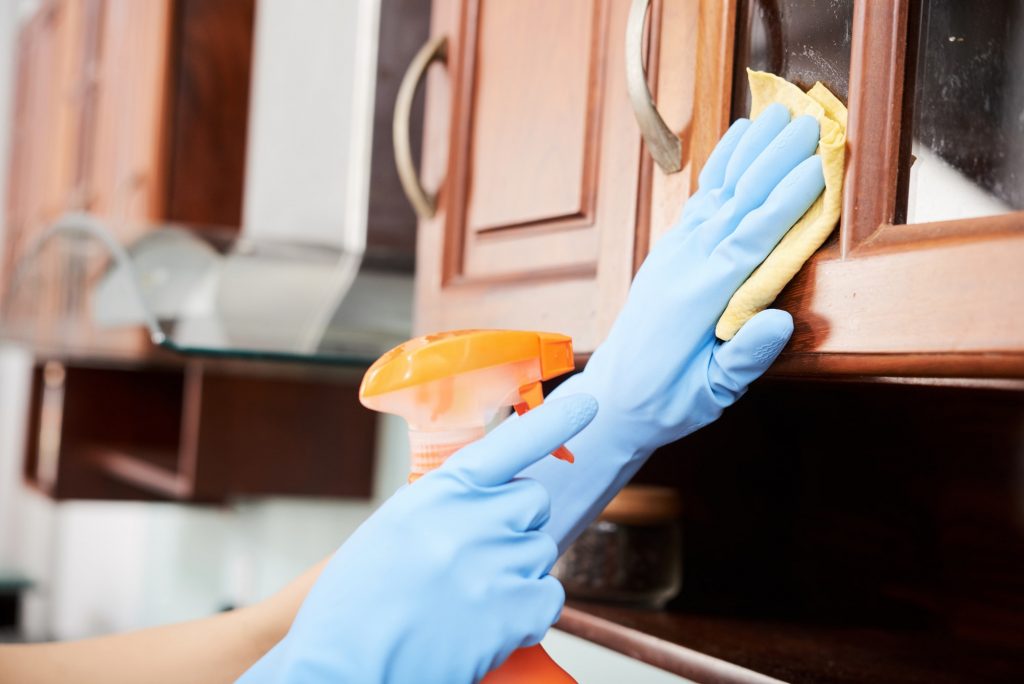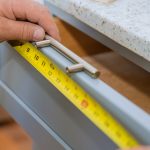Wood cabinets are a beautiful kitchen feature, and they’re not very high maintenance, but you should lightly clean and polish them at least once a week. There are a ton of wood cleaner products designed to clean and protect natural wood. Most of them are made with nourishing oils and mild soaps, which is great for the longevity of your cabinets, but it doesn’t go a long way for cleaning those tough soils you see in the kitchen.
If you cook a lot or even a little, you’re probably familiar with that layer of grease that tends to build on the cabinets around the stove and those greasy fingerprints that end up all over and all around the handles and pull grooves. Good News! You can clean stubborn, greasy cabinet soils without stripping your wood or diminishing the overall lifespan of the cabinets and hardware. In fact, you probably have everything you need already under your sink or in your utility room.
How to Clean Wood Cabinets

Just like for many of your other household cleaning problems, it’s vinegar and water to the rescue. Mix a half-and-half solution in a spray bottle, and be sure to use warm or hot water. It helps to break up the older layers of grime. When you spray your cabinets, don’t soak them. A gentle mist should be plenty for the main panels and body. Leave the mixture sitting for just a few minutes to soften the soils, then wipe clean with a soft cloth.
Has it been a while since the last cleaning of your cabinets? Try wiping them off with a wet cloth before spraying the mixture. That will remove any loose dirt and grime that might weaken the effects. Don’t forget to wipe down the hardware as well. Handles and pull grooves usually accumulate more fingerprints, oils, and grease than the rest of the cabinets. Use a clean, wet cloth to remove any remaining vinegar, then make sure the cabinets are completely dry.
How to Remove Grease and Grime Buildup
In most kitchens, that technique will work for light, daily cleaning, but it won’t do much for your old, caked-on greasy areas around the stove or the spots where little hands leave little marks every day. If you’re struggling with these heavier soils, go ahead and do the vinegar and water wipe down, but before you rinse and dry, let’s address these problem areas.
For general greasiness around the stove, add a few drops of grease-busting dish detergent or specialized grease cleaner to your vinegar solution and let sit for several minutes. Be sure to get in and around the hardware and pull grooves too. If you’re having trouble reaching into crevices with a cloth, try using a cheap toothbrush or cotton buds. Older grease spots might require a bit of elbow grease.

If you’re still struggling with greasy cabinets, there are a couple of methods you can try to make your solution a little more abrasive (but not too much). Adding salt to the mix and using it directly on the cloth can help cut through layers of dried-on grease without being hard on your real wood cabinets. Alternatively, you can create a separate solution of warm water and baking soda with a touch of lemon juice. This solution is more of a chemical abrasive than a physical abrasive. Both mixtures can have a drying effect, so you’ll definitely want to follow with a good rinse, dry, and polish to help rejuvenate the wood.
How to Polish Wood
The most effective way to polish your wood cabinets is to pick up a polish from the store that’s specifically made for that type of wooden cabinetry. If you prefer to use more natural or homemade products, you can typically use linseed oil or jojoba oil. Neither of these is food and will not expire or spoil. Apply the mixture with a soft sponge or cloth and let sit for a few minutes before buffing away with a dry cloth. This step will help prevent any damage from the cleaning and will protect your wood cabinets from future soiling and moisture damage. You should re-polish your cabinetry any time you apply water, soap, or physical cleaning methods.
What Not to Use
The first thing most people do when they need advice on how to clean greasy kitchen buildup from wood cabinets get online and search. However, you’ll probably find some solutions with potentially serious downsides. One popular suggestion for natural wood cabinet polishing is to use the olive oil from your pantry. Most instructions say to apply and buff, same as you would do with a regular polish. The downside is that olive oil does eventually spoil and will leave a funky smell all over your kitchen.
Another popular suggestion is to add lemon juice to your polish. Again, lemon juice will eventually spoil and smell, so unless you’re deep-cleaning your cabinets every couple of days, it’s not a good idea to apply food as a leave-on step. Also, lemon juice is more abrasive than many people realize. If you were to add too much or leave it on too long, you might find yourself with slightly bleached and dried-out cabinetry. That is definitely not the purpose of a polish. Lemon juice in your cleaning mixture is typically safe because you’re not leaving it on for more than a few minutes. If you do use lemon juice in your cleaning phase, be sure to rinse well and follow with a polish.
Scrubbing Tools
During cleaning, it can be really tempting to grab the steel wool and go to town on those stubborn greasy spots, but this is another big no-no. Real wood cabinets, painted cabinets, metal cabinets, and basically, any type of cabinets can be scratched and damaged from abrasive scrubbers. Salt in your vinegar solution or lemon juice with baking soda is as abrasive as you should get with cabinets. The rest is down to the grease-cutting soap and elbow hard work.
Are you still trying to decide on what type of cabinet door to go with? Check out this post on How To Choose Your Perfect Cabinet Door. In that post, you will find more information on the different options available.





